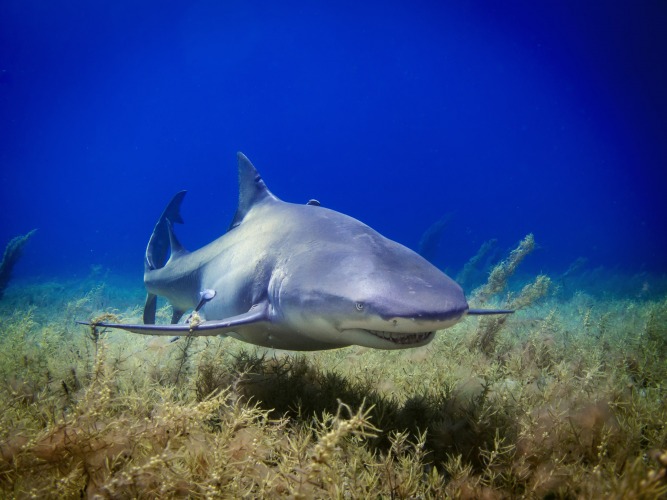Yes, from the blue shark to the brown catshark, Canada has nearly 60 species of sharks.
These sharks include endemic species that are native to the area, as well as species of sharks that travel around the world by water.
Sharks live in both saltwater that borders the western and eastern parts of Canada, as well as in some freshwater areas.
Find out where sharks are living in Canada, and how to deal with swimming in shark-infested waters if you are visiting the country.
Contents
So… Are There Sharks in Canada?
Canada is home to many sharks that swim on either coast.
From the West Coast of British Columbia to the East Coast of Newfoundland, Canada is surrounded by ocean waters.
The Pacific on the west, the Atlantic on the east, and the Arctic on the north are the oceans around Canada.
All of these are shark infested.
In addition, sharks that live in freshwater and saltwater are finding their way upstream in some lagoons and channels.
This is in mangroves and swamps where the waters are too shallow for most large sharks to survive.

There are three regions where sharks live around Canada.
This includes the Pacific Ocean, the Atlantic Ocean, and the Arctic Ocean.
Find out which sharks live in each of the saltwater oceans surrounding Canada.
In the Arctic Ocean, there are sharks that live in the world’s coldest waters.
This is home to polar bears, puffins, narwhals, and beluga whales.
Sharks that live in the Arctic Ocean include the Greenland shark, salmon shark, somniosidae, and Pacific sleeper sharks.
\Many sharks from the Pacific Ocean swim up to the Arctic waters by way of the British Columbia, Canada coastline.
Here you see salmon sharks, basking sharks, and dogfish sharks, including black and spiny species of dogfish.
The East Coast of Canada comprises Nova Scotia, Prince Edward Island, Newfoundland, and most of New Brunswick.
Here, there are Greenland sharks native to the area, as well as basking sharks, shortfin makos, great white sharks, blue sharks, common thresher sharks, and the popular porbeagle sharks.
Is it Safe to Swim in Canada?
Yes, it is safe to swim in the freshwater lakes and rivers of Canada.
As for the oceans, there are supervised beaches that are designated for swimming.
These will be monitored and patrolled by lifeguards and coast guards to protect against any sharks.
Interesting Shark Facts in Canada
The Government of Canada published a detailed report about the sharks found in the nation’s waters.
In Canada, sharks are not as dangerous to humans as compared to other places, such as Australia.
Mostly it is great white sharks that are attacking ships and small craft.
The majority of sharks in the waters live too deep or are too small to do much damage to humans.
Therefore, shark attacks and fatalities are nearly impossible to consider in Canada.
The sharks in Canada live in the ocean, which is saltwater. In fact, most sharks live in saltwater, except for a few like the bull shark that can survive in freshwater.
As Canada has the longest coastal border of any country, there are plenty of waterways for sharks to swim in.
But do sharks live in freshwater in Canada?
No, there are no sharks in the freshwater lakes and rivers of Canada.
Here’s why.
The water is too cold for sharks to survive inland and without enough space.
Lake Ontario, which is on the southern border of Canada and the northern border of the US, the lake is too cold for sharks to survive.
Anything north of this lake is going to be too cold as well, due to the geography.
How do sharks live in cold ocean waters in Canada then?
It has to do with currents.
The sharks swimming along the oceans are coming up from another ocean and through a current.
Therefore, they are not stuck in a certain waterway, such as a lake or river, where they must endure the cold water the entire time.
Also, there are different species of sharks living in saltwater versus freshwater.
Generally, sharks that live in freshwater are at the opening of rivers or at tributaries of lakes and ponds.
This is because a shark could find food more easily at these nesting grounds, and then still swim back to saltwater.
The lagoons and mangrove swamps of these waterways are also popular for sharks to live in.
That is because the water has a higher concentration of salt compared to other freshwater sources, but does not have as much salt as the ocean.
Some shark species have adapted to be able to swim up toward freshwater and survive by tolerating the change in salt concentration.
The real issue for sharks in Canada is swimming in too cold water.
The other reason why freshwaters are too cold and saltwater is fine for Canadian sharks has to do with the depth of the waterway.
Most lakes and rivers are far too shallow for sharks to survive, and this also accounts for how cold these waters are when the temperature dips.
Canada is a cold country and the northern border is located in the Arctic Circle, aka the North Pole.
This is the coldest place in the Northern Hemisphere and sharks have a difficult time surviving in that climate.
The cold, fast-moving waters of the Arctic Ocean are home to some types of sharks but not all of them.
The Atlantic and the Pacific oceans both bring up sharks that are accustomed to subtropical and tropical climates.
There is no way these sharks would survive in the cold climate of the Arctic Circle–or the strange predators of the polar bears and other species only found in this region.

3 Safety Tips for Swimming in Shark-infested Waters
- The Canadian Shark Attack Registry stated you should not fish with fish bait. This includes fish guts and parts, as well as fish food, dumped into a water source. The fish will attract any nearby sharks that are hungry, and you want to avoid being in the mix.
- Swim where there are lifeguards present if you are concerned about sharks. Lifeguards are there to identify sharks who are trying to find something to eat–such as human swimmers. They will be able to see anything swimming behind you, and are able to provide medical support and emergency relief in case of a shark attack.
- Avoid swimming at meal times for sharks, which are first thing in the daytime and right at dusk. These are times when the sun is not shining directly overhead and it is safer for fish to swim without being seen by fishermen. Sharks take advantage of the change of light to go feed for themselves.
You also cannot see the water and land as clearly at dawn or dusk, and there are generally fewer people out swimming before dawn and after dusk.
Swim from 10 am to 2 pm for best conditions in terms of lighting.
The sun goes down earlier in Canada compared to the US, so if you are traveling to Canada’s coasts, be ready to go in earlier than usual.
Summary
Canada is home to some sharks, but not as many as more shark-infested countries.
The majority of sharks in Canada live in the three oceans that surround the country.
Here you can find the most feared sharks of them all–the great white shark.
These and other cold-weather sharks live as far north as the Arctic Ocean with polar bears.
If you want to swim with sharks, there is a good chance you could do that when swimming in Canada at a public beach.
Canada Safety Overview
READ THE FULL REPORT: Canada Safety Review
Safety Index:
- OVERALL RISK: LOW
- TRANSPORT & TAXIS RISK: LOW
- PICKPOCKETS RISK: LOW
- NATURAL DISASTERS RISK: LOW
- MUGGING RISK: LOW
- TERRORISM RISK: LOW
- SCAMS RISK: LOW
- WOMEN TRAVELERS RISK: LOW
Frequently Asked Questions
Is swimming a popular sport in Canada?
According to the Swim Guide, in Canada, swimming is the third most popular sporting activity.
Swimming is behind hockey and golfing.
That means you are likely to swim while in Canada, either living or visiting.
Knowing how to navigate in shark-infested waters is key to your safety when swimming in Canada.
If you are interested in swimming outdoors in Canada, talk to the local community parks and recreation departments.
Find out where the local swimming beaches are located, and what you need to do to be safe from sharks.
This is going to be the best way to stay up to date on the latest information about sharks in Canadian waters where swimming is popular.
What should I do to protect against sharks when boating in Canada?
Avoid boating when the weather conditions are changing.
Any sudden winds or storms can churn up the water and stir up fish, followed by sharks.
This can also make swimming or navigating small or large craft difficult on the water.
Check the weather before you head out for a boat trip in Canada–and hope for smooth sailing ahead.
As for keeping away from sharks, such as great whites, stay in groups and travel in packs if at all possible.
Do not travel alone, unless you must, especially if you are going far away from Canada or along the coast.
If you have just your own boating vessel, whether you are in a sea kayak or on a fishing boat, you are more likely to be attacked by a great white shark.
This is because the bottom of your boat looks like a walrus or porpoise.
However, if you have a group of boaters, this makes the base of the boats look like a large sea creature or an unusually big animal.
Sharks are less likely to attack in this case.
Have there been shark attacks and/or fatalities in Canada due to sharks?
Yes.
Shark Attack Data reported there have been three attacks by sharks in Canada since 1891 and one was fatal.
Compare this to the US where 144 people have died and there have been 1,533 non-fatal attacks by sharks.
There have been far fewer deaths by sharks in Canada compared to the US and other countries.
However, the Government of Canada stated there have been more than a dozen shark attacks in Canada.
These are very rare occurrences, though, and due to unusual circumstances.












In my opinion, Canada’s diverse range of shark species and the fact that they are not as dangerous to humans as in other parts of the world makes it a unique and relatively safe place for swimming and exploring marine life.